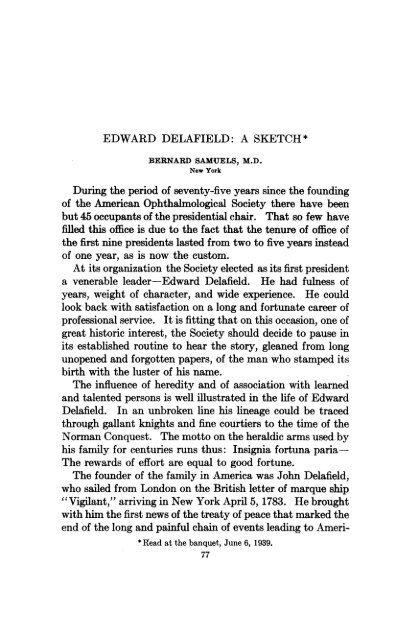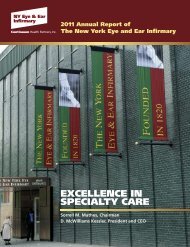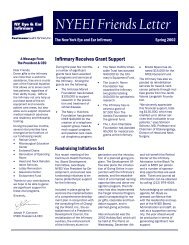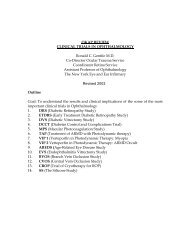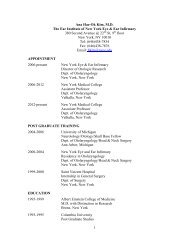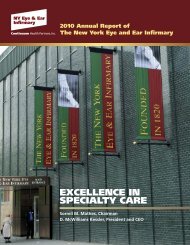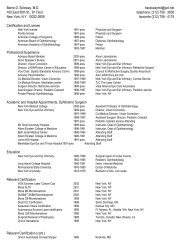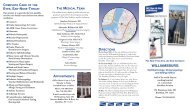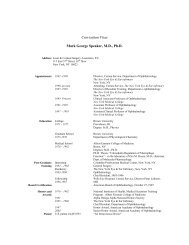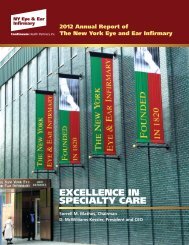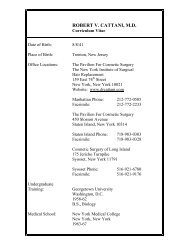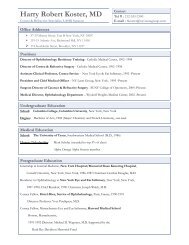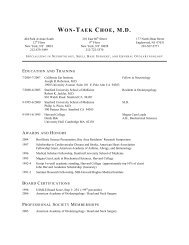recently uncovered biography of Edward Delafield, MD
recently uncovered biography of Edward Delafield, MD
recently uncovered biography of Edward Delafield, MD
Create successful ePaper yourself
Turn your PDF publications into a flip-book with our unique Google optimized e-Paper software.
EDWARD DELAFIELD: A SKETCH*<br />
BERNARD SAMUELS M.D.<br />
New York<br />
During the period <strong>of</strong> seventy-five years since the founding<br />
<strong>of</strong> the American Ophthalmological Society there have been<br />
but 45 occupants <strong>of</strong> the presidential chair. That so few have<br />
filled this <strong>of</strong>fice is due to the fact that the tenure <strong>of</strong> <strong>of</strong>fice <strong>of</strong><br />
the first nine presidents lasted from two to five years instead<br />
<strong>of</strong> one year, as is now the custom.<br />
At its organization the Society elected as its first president<br />
a venerable leader-<strong>Edward</strong> <strong>Delafield</strong>. He had fulness <strong>of</strong><br />
years, weight <strong>of</strong> character, and wide experience. He could<br />
look back with satisfaction on a long and fortunate career <strong>of</strong><br />
pr<strong>of</strong>essional service. It is fitting that on this occasion, one <strong>of</strong><br />
great historic interest, the Society should decide to pause in<br />
its established routine to hear the story, gleaned from long<br />
unopened and forgotten papers, <strong>of</strong> the man who stamped its<br />
birth with the luster <strong>of</strong> his name.<br />
The influence <strong>of</strong> heredity and <strong>of</strong> association with learned<br />
and talented persons is well illustrated in the life <strong>of</strong> <strong>Edward</strong><br />
<strong>Delafield</strong>. In an unbroken line his lineage could be traced<br />
through gallant knights and fine courtiers to the time <strong>of</strong> the<br />
Norman Conquest. The motto on the heraldic arms used by<br />
his family for centuries runs thus: Insignia fortuna paria-<br />
The rewards <strong>of</strong> effort are equal to good fortune.<br />
The founder <strong>of</strong> the family in America was John <strong>Delafield</strong>,<br />
who sailed from London on the British letter <strong>of</strong> marque ship<br />
"Vigilant," arriving in New York April 5, 1783. He brought<br />
with him the first news <strong>of</strong> the treaty <strong>of</strong> peace that marked the<br />
end <strong>of</strong> the long and painful chain <strong>of</strong> events leading to Ameri-<br />
*Read at the banquet, June 6, 1939.<br />
77
78<br />
SAMUELS: <strong>Edward</strong> <strong>Delafield</strong>: A Sketch<br />
can independence and also an <strong>of</strong>ficial copy <strong>of</strong> the treaty. He<br />
found the British flag still flying over the city and over a<br />
great fleet in the harbor, and so it was to be until some months<br />
later, when Lord Howe could gather up the last <strong>of</strong> the<br />
loyalists and ship them to Canada. New York was already<br />
over a hundred years old, and most <strong>of</strong> the patrician families<br />
were <strong>of</strong> Dutch or Huguenot descent. Within a few years<br />
John <strong>Delafield</strong> became rich and prominent. His summer<br />
home, "Sunswick House," at Hallett's Point, Long Island,<br />
with its famous gardens, was regarded as one <strong>of</strong> the most<br />
spacious and elegant seats near New York.<br />
<strong>Edward</strong> <strong>Delafield</strong>, born May 7, 1794, was one <strong>of</strong> 14 children<br />
(seven boys and seven girls) born to John and Ann Hallett<br />
<strong>Delafield</strong>. Through his mother there flowed hot in his veins<br />
the blood <strong>of</strong> revolutionary patriots.<br />
He was prepared for Yale at Union Hall Academy, at<br />
Jamaica, Long Island, under the tutelage <strong>of</strong> Mr. L. E. A.<br />
Eigenbrodt, a German scholar <strong>of</strong> distinguished ability, a<br />
graduate <strong>of</strong> the University <strong>of</strong> Giessen in 1793. Having made<br />
satisfactory progress in French, mathematics, and classic<br />
studies, he matriculated at Yale, and was graduated Bachelor<br />
<strong>of</strong> Arts in the class <strong>of</strong> 1812.<br />
Determining on a career <strong>of</strong> medicine, he was articled to<br />
Dr. Samuel Borrowe, a practitioner <strong>of</strong> great fame in New<br />
York, and at the same time he diligently pursued the prescribed<br />
course at the College <strong>of</strong> Physicians and Surgeons.<br />
The war <strong>of</strong> 1812 interrupted his studies, but presumably enlarged<br />
his practical knowledge. While the British were<br />
blockading the harbor <strong>of</strong> New York in 1814, a rumor arose<br />
that the city would soon be attacked by a powerful expedition<br />
<strong>of</strong> land and sea forces. Commodore Stephen Decatur was<br />
given charge <strong>of</strong> the defenses <strong>of</strong> the city. Responding to a<br />
public plea for aid, young <strong>Delafield</strong> volunteered as a private<br />
in a corps known as "The Iron Grays." Among the last<br />
survivors were <strong>Edward</strong> <strong>Delafield</strong> and Fitz-Greene Halleck,
Fig. 1.-<strong>Edward</strong> <strong>Delafield</strong> in youth. Fig. 2.-Elenor Langdon Elwyn, married<br />
to <strong>Edward</strong> <strong>Delafield</strong> in 1821.<br />
.~~~~~~-4 .#<br />
Fig. 3.-The <strong>Delafield</strong><br />
coat <strong>of</strong> arms.<br />
";<br />
Fig. 4.-New York Hospital.
Fig. 5.-Wright Post, Consultant<br />
Surgeon to the New York Eye Infirmair,<br />
1820-1828.<br />
Fig. 6.--Samuiel BorIowe, Consuiltanlt Stirgeon<br />
to the New York E}ye Infirm ary.<br />
Fig. 7.-The New York Eye an(d Ear Infirnmary in 1865. Fig. 8. -<strong>Edward</strong> <strong>Delafield</strong> in oict age.
SAMUELS: <strong>Edward</strong> <strong>Delafield</strong>: A Sketch<br />
whose couplet to the memory <strong>of</strong> Joseph Rodman Drake,<br />
"None knew thee but to love thee, nor named thee but to<br />
praise," has brought comfort to the hearts <strong>of</strong> thousands in<br />
recalling some dear departed friend. The records <strong>of</strong> the War<br />
Department show that toward the end <strong>of</strong> the war <strong>Delafield</strong><br />
served as surgeon's mate and afterward as surgeon in Major<br />
James T. Leonard's Battalion <strong>of</strong> "Sea Fencibles," New York<br />
Militia, until March 1, 1815. Peace had been signed in Paris<br />
on Christmas Day, 1814, but the news did not reach these<br />
shores until February 4, 1815. The rejoicing in the city was<br />
unbounded, for not only had its commerce suffered in this<br />
second war with England, but prior to this Napoleon's decrees<br />
<strong>of</strong> Berlin and Milan and Jefferson's Embargo Act had<br />
caused its ships to be held in port and to rot at the wharves.<br />
On the basis <strong>of</strong> his war record the first President <strong>of</strong> this Society<br />
was granted 160 acres <strong>of</strong> bounty land in 1855 and a<br />
pension in 1872.<br />
After receiving the degree <strong>of</strong> Doctor <strong>of</strong> Medicine from the<br />
College <strong>of</strong> Physicians and Surgeons <strong>of</strong> New York he served<br />
the customary year at New York Hospital as house physician.<br />
In the summer <strong>of</strong> 1816 he sailed for London to complete<br />
his studies abroad. Among his classmates at the<br />
College <strong>of</strong> Physicians and Surgeons was John Kearny<br />
Rodgers, whose surgical achievements in years to come were<br />
destined to be the pride and boast <strong>of</strong> the surgical arena <strong>of</strong><br />
New York Hospital, and <strong>of</strong> whom <strong>Delafield</strong> wrote: "Living<br />
and laboring together in a common cause, a friendship begun<br />
in student days, under the same masters, was cemented in a<br />
bond which death alone dissolved." Rodgers preceded him<br />
to London, where again they lived and studied together.<br />
They were pupils <strong>of</strong> Haighton, Cline, Astley Cooper, Abernethy,<br />
Lawrence, and Travers, whose names recall the glory<br />
<strong>of</strong> the great medical schools <strong>of</strong> St. Thomas's, Guy's, and St.<br />
Bartholomew's hospitals during the first quarter <strong>of</strong> the nineteenth<br />
century. Under the guidance <strong>of</strong> so illustrious a<br />
79
80<br />
SAMUELS: <strong>Edward</strong> <strong>Delafield</strong>: A Sketch<br />
coterie, each name eloquent in its own right, it was small<br />
wonder that London had superseded Paris as the surgical<br />
center <strong>of</strong> the world. The notes that <strong>Delafield</strong> made, chiefly<br />
from the lectures <strong>of</strong> Abernethy and Cooper, are preserved<br />
among the treasures <strong>of</strong> the New York Academy <strong>of</strong> Medicine,<br />
and are contained in five quarto volumes, covering 3,313<br />
closely written pages, all accurately indexed. The penmanship<br />
is exquisite and the pages are replete with nuggets <strong>of</strong><br />
knowledge.<br />
During <strong>Delafield</strong>'s and Rodgers' sojourn in London life was<br />
probably not so gay as it had been a few years before. The<br />
Prince Regent, acting for King George III, had grown older<br />
and wiser, and Beau Brummel had fled to Paris to escape a<br />
debtor's prison in England. It was some time later that<br />
Astley Cooper removed the famous wen from the scalp <strong>of</strong><br />
King William IV, who, as the Duke <strong>of</strong> Clarence, visited<br />
Admiral Digby in New York during the Revolution, and<br />
who would have lost his life by drowning in the city's Fresh<br />
Water Pond had not the father <strong>of</strong> Fitz-Greene Halleck<br />
rescued him.<br />
While "walking" the wards at Guy's and St. Thomas's<br />
hospitals <strong>Delafield</strong> and Rodgers were advised to matriculate<br />
in the <strong>recently</strong> established London Infirmary for Curing Diseases<br />
<strong>of</strong> the Eye (since renowned as the Royal London<br />
Ophthalmic Hospital). This charity had been founded by<br />
young Cunningham Saunders, out <strong>of</strong> sympathy, it was said,<br />
for the soldiers seen on the streets <strong>of</strong> London who were<br />
blinded by wounds or by trachoma contracted in the expedition<br />
against Napoleon in Egypt. It was at this infirmary that<br />
these two young physicians learned that, although they had<br />
received the best medical training their own country could<br />
give, they had been taught practically nothing about diseases<br />
<strong>of</strong> the eye.<br />
The story <strong>of</strong> how they then resolved to found a similar institution,<br />
"for the first time in America," for the exclusive
SAMUELS: <strong>Edward</strong> <strong>Delafield</strong>: A Sketch<br />
treatment <strong>of</strong> diseases <strong>of</strong> the eye, has become legendary.<br />
could exclaim with the Ancient Mariner,<br />
"We were the first that ever burst<br />
Into that silent sea."<br />
They<br />
Shortly after their return home, on their own responsibility<br />
and at their own expense, they leased two rooms in an upper<br />
story <strong>of</strong> a small brick building at 65 Chatham Street, New<br />
York, and publicly announced that there the poor could obtain<br />
treatment for diseases <strong>of</strong> the eye and receive medicine<br />
gratuitously. Those walls, given now to baser purposes, still<br />
stand under the great steel beams <strong>of</strong> the approach to the<br />
Brooklyn Bridge. There two men, not many years after<br />
attaining their majority, labored for their fellow man in a<br />
way then novel in this country. As has been said by another<br />
writer, "wherever man has wrought for his fellow man that<br />
is hallowed soil."<br />
This small beginning, undertaken by two youthful workers,<br />
may be considered the most important episode in the history<br />
<strong>of</strong> American ophthalmology. It was made in the year 1820,<br />
when James Monroe was President, during the "era <strong>of</strong> good<br />
feeling," and only six months after George III, insane and<br />
blind, had ended his reign. This undertaking led directly to<br />
the foundation <strong>of</strong> the New York Eye and Ear Infirmary, and<br />
within a short time to that <strong>of</strong> the Massachusetts Eye and Ear<br />
Infirmary and <strong>of</strong> the Wills Eye Hospital.<br />
Soon after the founding <strong>of</strong> the Infirmary, <strong>Delafield</strong> became<br />
a partner <strong>of</strong> his old preceptor, Samuel Borrowe. Borrowe<br />
and Wright Post were the first consultant surgeons <strong>of</strong> the<br />
Infirmary, and these two men, who had guided <strong>Delafield</strong> in<br />
his student days, were held by him in the highest esteem and<br />
gratitude for the remainder <strong>of</strong> his life. A large and lucrative<br />
practice soon flowed into his <strong>of</strong>fice. Few men have attained<br />
eminence so rapidly. In 1826, at the early age <strong>of</strong> thirty-two<br />
years, he was appointed Pr<strong>of</strong>essor <strong>of</strong> Obstetrics and Diseases<br />
81
82<br />
SAMUELS: <strong>Edward</strong> <strong>Delafield</strong>: A Sketch<br />
<strong>of</strong> Women and Children at the College <strong>of</strong> Physicians and<br />
Surgeons. He had a great reverence for womanhood and for<br />
maternity, and, as portions <strong>of</strong> his lectures testify, he strove<br />
to inculcate this reverence in his students. In 1834 he was<br />
appointed Attending Physician to New York Hospital. By<br />
1838 his large and increasing private practice obliged him to<br />
withdraw from both positions, but he continued his labors at<br />
the Eye Infirmary until his death.<br />
In 1842 he carried out a project that he had long contemplated,<br />
namely, the founding <strong>of</strong> the New York Society for the<br />
Relief <strong>of</strong> Widows and Orphans <strong>of</strong> Medical Men. This Society<br />
was organized at a special gathering <strong>of</strong> physicians at <strong>Delafield</strong>'s<br />
residence. It is unique in its functions, in the manner<br />
<strong>of</strong> conserving its funds, and in distributing its benefits at an<br />
amazingly low cost <strong>of</strong> administration.<br />
There is an interesting connection between the Society for<br />
the Relief <strong>of</strong> Widows and Orphans <strong>of</strong> Medical Men and the<br />
New York Academy <strong>of</strong> Medicine. In 1846, on the occasion<br />
<strong>of</strong> the aforesaid Society's annual meeting, the conversation<br />
turned to the dissensions and problems <strong>of</strong> the times. <strong>Delafield</strong><br />
called attention to the need for an organization that<br />
would be devoted to the improvement <strong>of</strong> medical standards<br />
and education and to more effective service to the public.<br />
At this meeting, under his leadership, a comnmlittee was appointed<br />
to formulate plans for an Academy <strong>of</strong> Medicine.<br />
Dr. <strong>Delafield</strong> was elected the first president <strong>of</strong> the Academy<br />
when it was founded in 1847. From the very beginning <strong>Delafield</strong><br />
established the principles to which the Academy has<br />
always adhered-the avoidance <strong>of</strong> all political strife. Of how<br />
he stood in the politics <strong>of</strong> his country we have no inkling, but<br />
he must have been sensitive to the sectional bitterness and<br />
wrangling that are summed up in two famous toasts-" Our<br />
Federal Union, it must be preserved," by Jackson, and<br />
"Liberty dearer than the Union,"' by Calhoun.<br />
In 1839 he was elected a trustee <strong>of</strong> the College <strong>of</strong> Physicians
SAMUELS: <strong>Edward</strong> Delafleld: A Sketch<br />
and Surgeons. He was Vice-President from 1855 to 1858,<br />
when he was elevated to the presidency, holding this high<br />
<strong>of</strong>fice until his death seventeen years later. He effected the<br />
change in the relationship between the College and Columbia<br />
University on the basis on which it exists to-day. He took<br />
a most active part in organizing the Alumni Association <strong>of</strong><br />
the College <strong>of</strong> Physicians and Surgeons, and from his private<br />
resources he established the present Prize Fund <strong>of</strong> the Association.<br />
On January 23, 1856, in the absence <strong>of</strong> the President,<br />
he presided at the opening <strong>of</strong> the new college building<br />
at the corner <strong>of</strong> Twenty-third Street and Fourth Avenue.<br />
He began his address by giving a history <strong>of</strong> the college and<br />
biographical sketches <strong>of</strong> its late President, Wright Post, and<br />
<strong>of</strong> David Hosack, a contemporary and rival <strong>of</strong> Post's who is<br />
reputed to have been the most celebrated physician <strong>of</strong> his<br />
time in America.<br />
The year 1856 marked the fulfilment <strong>of</strong> a dream that <strong>Delafield</strong><br />
had entertained for thirty-six years, namely, the dedication<br />
<strong>of</strong> the new building for the New York Eye Infirmary, at<br />
the corner <strong>of</strong> Thirteenth Street and Second Avenue. At the<br />
opening exercises he delivered an address that gave a complete<br />
and intimate history <strong>of</strong> the institution. The building,<br />
the finest <strong>of</strong> its sort at the time, was believed to be so perfectly<br />
conceived and strongly constructed that it would last<br />
for generations, and yet in a little over two score years it had<br />
been replaced by the present structure. It was in this building<br />
that the American Ophthalmological Society held its first<br />
meeting in 1864.<br />
As President <strong>of</strong> the College <strong>of</strong> Physicians and Surgeons<br />
<strong>Edward</strong> <strong>Delafield</strong> became a member <strong>of</strong> the Board <strong>of</strong> Governors<br />
<strong>of</strong> Roosevelt Hospital. He was elected its first President,<br />
and he laid its foundation stone in 1869, in the presence <strong>of</strong> the<br />
President <strong>of</strong> the United States and a most distinguished<br />
gathering. As Chairman <strong>of</strong> the Building Committee he supervised<br />
every detail <strong>of</strong> its construction, in which were incor-<br />
83
84<br />
SAMUELS: <strong>Edward</strong> <strong>Delafield</strong>: A Sketch<br />
porated many <strong>of</strong> his own ideas. When at last the great building<br />
was completed, he presided at its opening exercises. This<br />
magnificent hospital was the gift <strong>of</strong> James H. Roosevelt.<br />
The world had not known such munificence for the relief <strong>of</strong><br />
human suffering since the foundation <strong>of</strong> Guy's Hospital in<br />
London in 1724 by Thomas Guy, and <strong>of</strong> Wills Eye Hospital<br />
in Philadelphia in 1831 by James Wills. All three founders<br />
were bachelors. It has been observed that a great hospital,<br />
like a great collegiate foundation, frequently originates in the<br />
beneficence <strong>of</strong> a single founder.<br />
At the time <strong>of</strong> the opening <strong>of</strong> Roosevelt Hospital <strong>Edward</strong><br />
<strong>Delafield</strong> was nearing old age. In the decades that had gone<br />
by since, in the first flush <strong>of</strong> youth, he left New York Hospital,<br />
with its lovely lawns and l<strong>of</strong>ty elms on lower Broadway, he<br />
had taken part in so many medical projects-one duty fulfilled<br />
creating another-that it was said <strong>of</strong> him that he probably<br />
contributed more than any man <strong>of</strong> his time to the<br />
promotion <strong>of</strong> intelligent and efficient organization <strong>of</strong> public<br />
ends in the medical pr<strong>of</strong>ession <strong>of</strong> New York City. The combination<br />
<strong>of</strong> sound practical judgment and philanthropic conceptions,<br />
together with the will power to carry out great<br />
enterprises, is rare. It was found in full potency in <strong>Edward</strong><br />
<strong>Delafield</strong>.<br />
Notwithstanding the time and energy expended in organizational<br />
activities and in a large practice, he never relinquished<br />
his interest in or his connection with ophthalmology.<br />
He continued to be an active surgeon at the Infirmary from<br />
1820 to 1850, when he became Consulting Surgeon, and in<br />
1871 he was appointed Vice-President. On the occasion <strong>of</strong><br />
the fiftieth anniversary <strong>of</strong> the Infirmary he delivered an<br />
address in the institution describing how it came to be<br />
founded, "the first <strong>of</strong> its kind in America." He stood alone,<br />
the sole survivor <strong>of</strong> the founding fathers.<br />
Much <strong>of</strong> his fame as a practitioner was derived from his<br />
successful treatment <strong>of</strong> diseases <strong>of</strong> the eye. <strong>Delafield</strong> was
SAMUELS: <strong>Edward</strong> <strong>Delafield</strong>: A Sketch<br />
not only a specialist himself, but he was a champion <strong>of</strong> specialists,<br />
ever pointing out to the general practitioner the advantage<br />
<strong>of</strong> having some one to consult who has devoted his<br />
time and energy to one particular branch <strong>of</strong> medicine. He<br />
reserved the right to treat any disease <strong>of</strong> the body that he<br />
considered might be affecting the organs <strong>of</strong> vision. He<br />
would say to his students that one may continue his pupilage<br />
through life, but that there is much knowledge that, if not<br />
obtained in school, will never be acquired later on. In early<br />
youth, before the heavy burdens they were destined to bear<br />
had been laid on his shoulders, he edited, with copious notes,<br />
Benjamin Travers' Synopsis on Diseases <strong>of</strong> the Eye. This<br />
edition, dedicated to Wright Post, was published in New<br />
York. Occasionally he contributed an article on ophthalmology<br />
to the journals. It is probably <strong>of</strong> slight consequence<br />
to-day whether he wrote much or not at all, so few <strong>of</strong> the ophthalmologic<br />
writings <strong>of</strong> his generation have endured. As<br />
Longfellow said:<br />
"Happy those whose written pages<br />
Perish with their lives,<br />
If among the crumbling ages<br />
Still their name survives."<br />
It was chiefly through the spoken word that <strong>Edward</strong> <strong>Delafield</strong><br />
conveyed his knowledge to two generations <strong>of</strong> students.<br />
As early as 1823 he gave clinical lectures on ophthalmology<br />
at the Infirmary. These were purposely held during the<br />
session <strong>of</strong> the College <strong>of</strong> Physicians and Surgeons, so that the<br />
undergraduates might take advantage <strong>of</strong> them. The lectures<br />
were very popular, filling a great need, and were continued<br />
over many years. It was not until 1866 that the College<br />
established an eye clinic over which Cornelius R. Agnew, who<br />
-had received his training at the Infirmary, presided.<br />
On every occasion <strong>Delafield</strong> evinced his interest in ophthalmology.<br />
Although he wrote no famous book and made<br />
no striking discovery, yet, by preparing the way for others to<br />
85
86<br />
SAMUELS: <strong>Edward</strong> <strong>Delafield</strong>: A Sketch<br />
do these things, he left us greatly in his debt. Projecting his<br />
aid to the Infirmary as far into the future as it was possible<br />
for him to do, he bequeathed it the sum <strong>of</strong> $5,000, "in trust,<br />
to invest and apply the interest or income to the management<br />
<strong>of</strong> a free bed." An equal sum was bequeathed to the<br />
Society for the Relief <strong>of</strong> Widows and Orphans <strong>of</strong> Medical<br />
Men. He had, however, already given money from his private<br />
funds to both institutions, being always reluctant to<br />
demand <strong>of</strong> others what he would not do himself.<br />
And now to lift the curtain <strong>of</strong> his private life: <strong>Edward</strong><br />
<strong>Delafield</strong> was twice married. By his first marriage in 1821 to<br />
Elenor Langdon Elwyn, a granddaughter <strong>of</strong> John Langdon,<br />
United States Senator and Governor <strong>of</strong> New Hampshire, six<br />
children were born. His wife died <strong>of</strong> "galloping consumption"<br />
at the age <strong>of</strong> thirty-five years, and one after another,<br />
as they grew up, the children died <strong>of</strong> the same disease. He<br />
had high hopes for his eldest son, <strong>Edward</strong> Henry <strong>Delafield</strong>, a<br />
graduate in medicine <strong>of</strong> the College <strong>of</strong> Physicians and Surgeons<br />
<strong>of</strong> the class <strong>of</strong> 1848. Young <strong>Delafield</strong> was a brilliant<br />
student and a youth <strong>of</strong> the greatest promise. One day, while<br />
"walking" the wards <strong>of</strong> one <strong>of</strong> the great London hospitals,<br />
he was stricken with a hemorrhage from the lungs. Hastening<br />
back to America, he died at sea, <strong>of</strong> "phthisis pulmonis,"<br />
aged only twenty-three years.<br />
By his second wife, Julia Floyd, whose paternal grandfather<br />
was General William Floyd, a signer <strong>of</strong> the Declaration<br />
<strong>of</strong> Independence, <strong>Edward</strong> <strong>Delafield</strong> had five children.<br />
His son by this marriage, Francis <strong>Delafield</strong>, followed in his<br />
father's footsteps. After graduating from Yale he entered<br />
the College <strong>of</strong> Physicians and Surgeons, receiving his medical<br />
diploma from the hands <strong>of</strong> his father in 1863. Not being permitted<br />
to take part in the stupendous struggle <strong>of</strong> the Civil<br />
War that was raging in the South, Francis <strong>Delafield</strong> was sent<br />
abroad to continue his work, studying general medicine in<br />
Paris and ophthalmology in Vienna. He became a famous
SAMUELS: <strong>Edward</strong> Delafleld: A Sketch<br />
pathologist, was honored by Yale with an LL.D., and was<br />
destined to perpetuate the name <strong>of</strong> <strong>Delafield</strong> in the medical<br />
world.<br />
<strong>Edward</strong> <strong>Delafield</strong> was a resident <strong>of</strong> New York City all his<br />
life, and it appears that he seldom if ever went far from his<br />
home town, for he was much too busy. His city house, which<br />
he built, was at No. 1 East Seventeenth Street. Any prominent<br />
physician visiting New York was almost sure to be entertained<br />
at his elegant and hospitable home. His family<br />
moved in an exclusive and cultivated society. His summer<br />
home, "Felsenh<strong>of</strong>," at Darien, Connecticut, still stands today,<br />
much as he left it, a mid-Victorian structure occupying<br />
an eminence overlooking Long Island Sound. If he could<br />
come back from the land <strong>of</strong> shadows,-and while I speak<br />
there seem to be hovering over us the spirits <strong>of</strong> those long<br />
departed, -he would have us know about his countryseat and<br />
the way in which he lived. In the wide hall <strong>of</strong> the house there<br />
are six shallow semicircular alcoves, which, in his day, were<br />
occupied by marble busts <strong>of</strong> his medical friends. As was the<br />
English custom, he aimed to make the place self-sustaining.<br />
Everything used on the table was grown there. Even the<br />
waters were utilized, oysters and clams being reclaimed from<br />
the river and fish from the Sound. There was a tidal dam,<br />
and a tidal mill where corn grown on the place was ground.<br />
The only foods purchased were sugar, tea, and c<strong>of</strong>fee. Behind<br />
the house there was an enormous English garden with<br />
box walks, which must have reminded him <strong>of</strong> his father's<br />
gardens at " Sunswick," in which he loitered in carefree boyhood.<br />
He had an affection for the noble horse, and was wont<br />
to be driven behind fine trotters between "Felsenh<strong>of</strong>" and<br />
New York.<br />
The household had an English air about it. Family prayers<br />
were held daily and had to be attended by all the members<br />
as well as by the servants. Of a religious nature, he was<br />
brought up in the Episcopal Church, <strong>of</strong> which he was a com-<br />
87
88<br />
SAMUELS: <strong>Edward</strong> Delajield: A Sketch<br />
municant and a vestryman. On his inward life the rites and<br />
ceremonials <strong>of</strong> that ancient church must have acted and reacted<br />
untold times. He was not only a great man, but he was<br />
a good man-one <strong>of</strong> those rare individuals who really practise<br />
their religion. He considered the use <strong>of</strong> tobacco a pernicious<br />
habit. In one <strong>of</strong> his annual charges to the graduating class<br />
he inveighed against the use <strong>of</strong> alcohol for medicinal purposes,<br />
but he kept a wine cellar that must have been well stocked,<br />
for in his will he directed that his wines be divided into six<br />
equal parts for distribution among his heirs. He was fond <strong>of</strong><br />
astronomy, and the telescope that he used is still at "Felsenh<strong>of</strong>."<br />
Toward the end <strong>of</strong> his life he measured five feet eight inches<br />
in height and weighed about 150 pounds. His eyes were blue,<br />
and in younger years his hair was reddish. Two portraits <strong>of</strong><br />
him, one in youth and the other in old age, hang in the<br />
Governors' Room at the Infirmary, and two busts <strong>of</strong> him are<br />
housed under the same ro<strong>of</strong>. Another portrait <strong>of</strong> him is at<br />
the Academy <strong>of</strong> Medicine and one is owned by Roosevelt<br />
Hospital. Says Carlyle: "Human portraits, faithfully<br />
drawn, are <strong>of</strong> all pictures the welcomest on human walls."<br />
On <strong>Delafield</strong>'s return to town from "Felsenh<strong>of</strong>," in the<br />
autumn <strong>of</strong> 1874, it was evident that his strength was failing,<br />
and that he was dwindling away in "the lean and slipper'd<br />
pantaloon." Hugh Reiley, his coachman for twenty-five<br />
years-" friend and coachman" as he called him in his willwould<br />
come into the house to help carry him upstairs at bedtime<br />
and to minister to him during his last months "in age<br />
and feebleness extreme."<br />
What changes in the world in general, and in medicine in<br />
particular, were encompassed in the one and eighty years <strong>of</strong><br />
his earthly pilgrimage! Napoleon had won his greatest victory<br />
at Austerlitz, and had been exiled in defeat and gloom<br />
after Waterloo. <strong>Delafield</strong> was at the zenith <strong>of</strong> his reputation<br />
when the great cable across the Atlantic was laid, and the
SAMUELS: <strong>Edward</strong> Delafleld: A Sketch<br />
dome <strong>of</strong> City Hall burned at the illumination in celebration<br />
<strong>of</strong> the first message received through the Transatlantic<br />
Cable. He saw this country annex, either by purchase or by<br />
war, Louisiana, California, Florida, and Alaska. In his<br />
youth most <strong>of</strong> the country beyond the Mississippi was inhabited<br />
by savages and wild beasts.<br />
He saw the advent <strong>of</strong> what he termed "the milder medicine."<br />
Patients were no longer bled to death, as it was<br />
claimed the Father <strong>of</strong> His Country had been, when he needed<br />
all the strength that he could muster. Patients were no<br />
longer drugged with opium and rum, nor held or strapped to<br />
the operating table, things he had witnessed in his student<br />
days. Crawford W. Long, a country practitioner in Georgia,<br />
had given the first nitrous ether in the history <strong>of</strong> surgery,<br />
and had converted a scene <strong>of</strong> mortal agony, through "magic<br />
sleep," into one <strong>of</strong> tranquillity, free <strong>of</strong> pain.<br />
<strong>Edward</strong> <strong>Delafield</strong> died on February 13, 1875. A vast concourse<br />
<strong>of</strong> mourners gathered under the l<strong>of</strong>ty arches <strong>of</strong> Trinity<br />
Church and crowded the sides <strong>of</strong> the adjacent street to pay<br />
tribute to him and to his brothers, Rufus and Henry <strong>Delafield</strong>,<br />
whose bodies lay before the altar beside his own. Singularly,<br />
all three, the last survivors <strong>of</strong> seven brothers, had<br />
died within three days. Their lives had been prolonged far<br />
beyond the Biblical allotted span. They were eminent men,<br />
each one an honor to his family and a credit to the city <strong>of</strong> his<br />
birth.<br />
In estimating the character <strong>of</strong> <strong>Edward</strong> <strong>Delafield</strong> a contemporary<br />
paper stated that many <strong>of</strong> his original ideas were<br />
"so incorporated in the works <strong>of</strong> the day that it would be<br />
difficult to give him all the credit justly his due."<br />
The Chaplain and a Trustee <strong>of</strong> the College <strong>of</strong> Physicians<br />
and Surgeons, who came <strong>of</strong>ten in intimate contact with him,<br />
the Rev. Sullivan H. Weston, in his memorial sermon portrayed<br />
him as I would have all those here present picture him<br />
to have been. He said: "He was eminently scholarly, with<br />
89
90 SAMUELS: <strong>Edward</strong> <strong>Delafield</strong>: A Sketch<br />
cultivated literary tastes; his language was at once chaste,<br />
select and forcible. He was a great favorite with his students.<br />
While affable to his intimate associates, he was at the same<br />
time dignified and reserved in his general manners. He knew<br />
how to resent an impertinence and check forwardness and<br />
presumption. No one who knew him ever thought <strong>of</strong> taking<br />
a liberty with him-his stately manner would at once rebuke<br />
any undue familiarity."<br />
Of all that our first President witnessed and accomplished<br />
during the days <strong>of</strong> his years only a tithe has been brought to<br />
light out <strong>of</strong> the distant past, but <strong>of</strong> it we have learned enough<br />
to seek the grace to emulate a noble, fruitful, and inspiring<br />
life.


